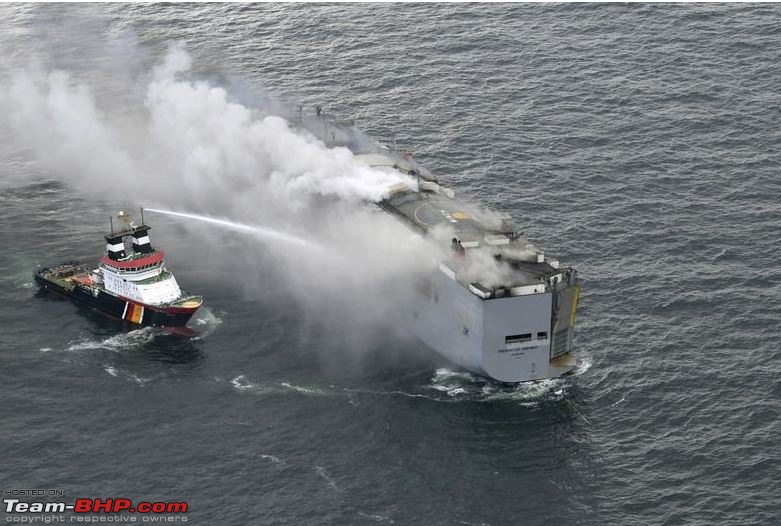| Re: Ship carrying 3,000 cars catches fire, burns off Dutch coast

Source: https://www.9news.com.au/world/ship-...2-2030030a7e1f
Cars and vehicles have been carried on vessels called "Car Carriers" and "Ro-Ro" since many decades. However what's changed now is that many of these cars are EV's which pose a great danger to the ships that they are carried it. They are a mix of combustible materials (mostly plastic), with inherent ignition sources. Now we have a very specific risk that Li-ion battery EVs pose when carried at sea in the same manner as all vehicles.
If EVs are not adequately lashed and a vessel encounters bad weather, the cars can become loose, have an impact, and cause a fire. A single vehicle fire could prove catastrophic and impossible for the limited number of crew to extinguish.
Unfortunately, some of the basic and widely relied upon fire safety principles are not available for Li-ion battery EV fires. There is no effective or practicable potential for early detection, warning, or fire suppression. There is, currently, no effective and capable fixed and portable fire fighting system for such fires. Even a modern, full-time, public fire service is unable to control a Li-ion EV fire in any timely manner. In short, at present, no ship’s system or crew nor any port or public fire service is capable of dealing effectively with the risk aboard. Aware of the rising risks from EV fires, the International Maritime Organization (IMO) issued a paper in June 2022 in which it said that fire fighting equipment and measures in existing ships carrying cars needed to be reassessed.
The following are all potential risk scenarios that could arise when transporting EVs:
1. Battery fire during on-board charging of the EV.
2. Battery fire due to increase in temperature from a fire in the surrounding area.
3. Battery fire after an accidental impact during cargo operation or vessel movement in bad weather.
4. Fire or explosion due to the escape of hydrogen from the fuel cell hydrogen pressure tank resulting from fire in the lower deck or surrounding area
5. Battery runaway due to an internal short circuit resulting from an impact, or poor battery quality leading to fire when the battery internal safety mechanisms stop working
In addition, a lithium-ion battery exposed to temperatures above 150 °C from a surrounding fire might start to discharge toxic gases with possible ignition. Quote:
Over recent years there have been numerous fires on vehicle carriers, some of which have been attributed to faults in the vehicles being carried onboard. The outcome of these vehicle carrier fires have, in the main, been significant. We have summarised a few of these incidents below.
On the MV Honor in February 2017, a fire in the upper vehicle deck was attributed to a fault in the starter motor solenoid in one of the vehicles being transported. The fire led to extensive damage to the Honor’s vehicle decks as well as its cargo of about 5,000 vehicles.
In May 2018, a fire started on the 11th deck of the Auto Banner. The fire was alleged to have been caused by the over-heating of one of the used vehicles on board. The fire was cooled by helicopters dropping water from the air and more than 40 fire engines spraying the hull. The entire crew of 28 were safely evacuated without any reported injuries.
Grande America suffered a fire in March 2018 and subsequently developed a starboard list, causing it to capsize and sink in a depth of around 4,600 metres. The resulting oil spill stretched for 10km and the ship was carrying 2,000 cars and 365 containers, of which 45 were deemed to hold hazardous substances.
Sincerity Ace caught fire in the Pacific on New Year’s Eve 2018 with more than 3,500 cars onboard. The crew had to abandon the vessel, and whilst 16 crew were rescued, five tragically died as a result of the incident.
In June 2019, Diamond Highway had to be abandoned by its crew in the South China Sea, due to fire, whilst carrying 6,354 cars. Thankfully, all 25 crew were rescued.
|
Source: https://safety4sea.com/car-carrier-f...ransportation/
MOL, which operates one of the world’s largest car carrier fleets, suffered this year’s largest shipping casualty to date in dollar terms when its 6,400 ceu vessel, Felicity Ace, caught fire and eventually sank off the Azores five weeks ago with losses, according to law firm Vinson & Elkins, in the region of $500m. The casualty was the fourth big car carrier blaze involving EVs since 2019.
The bottom line is that at present we still do not have proper systems on board for carriage of EV's.
Last edited by ruzbehxyz : 27th July 2023 at 09:47.
| 
 (30)
Thanks
(30)
Thanks
 (16)
Thanks
(16)
Thanks

 (13)
Thanks
(13)
Thanks

 (17)
Thanks
(17)
Thanks
 (7)
Thanks
(7)
Thanks
 (16)
Thanks
(16)
Thanks
 (12)
Thanks
(12)
Thanks
 (2)
Thanks
(2)
Thanks
 (12)
Thanks
(12)
Thanks

 (3)
Thanks
(3)
Thanks
 (25)
Thanks
(25)
Thanks


 (3)
Thanks
(3)
Thanks

 (4)
Thanks
(4)
Thanks











